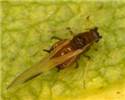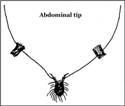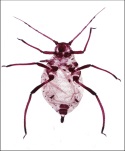Classification
Aphidinae: Aphidini
Diagnosis
Apterae small to medium-sized, grey-brown to reddish brown, on undersurface of leaves of host plants along the main veins, or in dense colonies on young shoots, attended by ants. Alatae have a reddish brown to dark-brown abdomen. Apterae and alatae both 1.3-2.4 mm long. Siphunculi always shorter than cauda; 0.04-0.06x as long as body. Body 1.5x as long as antennae.
The aphid can be easily distinguished from other Toxoptera species by the presence of very small siphunculi and absence of shiny abdominal dorsum in adults.
Distribution
South and southeast Asia; widespread in Africa south of the Sahara. Found throughout India.
Host plant(s)
Polyphagous on several hosts. Recorded on the following hosts in Karnataka: Anacardiaceae: Anacardium occidentale Blume., Mangifera indica L.; Rutaceae: Citrus sp.; Rubiaceae: Mussaenda frondosa Wall., Mussaenda erythrophylla Wall., Hamelia sp.; Malvaceae: Hibiscus rosa-sinensis L.; Verbenaceae: Clerodendron serratum Gaertn.
Measurements
Aptera: Length of body 2.18, width 1.28; antennae 1.39, segments III: IV: V: VI 0.37: 0.26: 0.23: (0.11+0.28); u.r.s. 0.14; h.t.2 0.09; siphunculus 0.09; cauda 0.20.
Alata: Length of body 2.22, width 1.08; antennae 1.39, segments III: IV: V: VI 0.32: 0.22: 0.24: (0.11+0.37); u.r.s. 0.13; h.t.2 0.10; siphunculus 0.07; cauda 0.17.
Seasonal occurrence
January-March and June-August.
Natural enemies
Coleoptera: Coccinellidae: Cheilomenes sexmaculata (F.), Coelophora bissellata Mulsant, Cryptogonus kapuri Ghorpade, C. quadriguttatus (Weise), Pseudaspidimerus trinotatus (Thunberg).
Braconidae: Aphidiinae: Aphidius matricariae Haliday, Ephedrus lacertosus (Haliday), Lipolexis scutellaris Mackauer, Trioxys indicus Subba Rao & Sharma.
_sml.jpg)

_sml.jpg)
_sml.jpg)
_sml.jpg)
_sml.jpg)
_sml.jpg)
_sml.jpg)

_sml.jpg)
_sml.jpg)
_sml.jpg)
_sml.jpg)
_sml.jpg)




